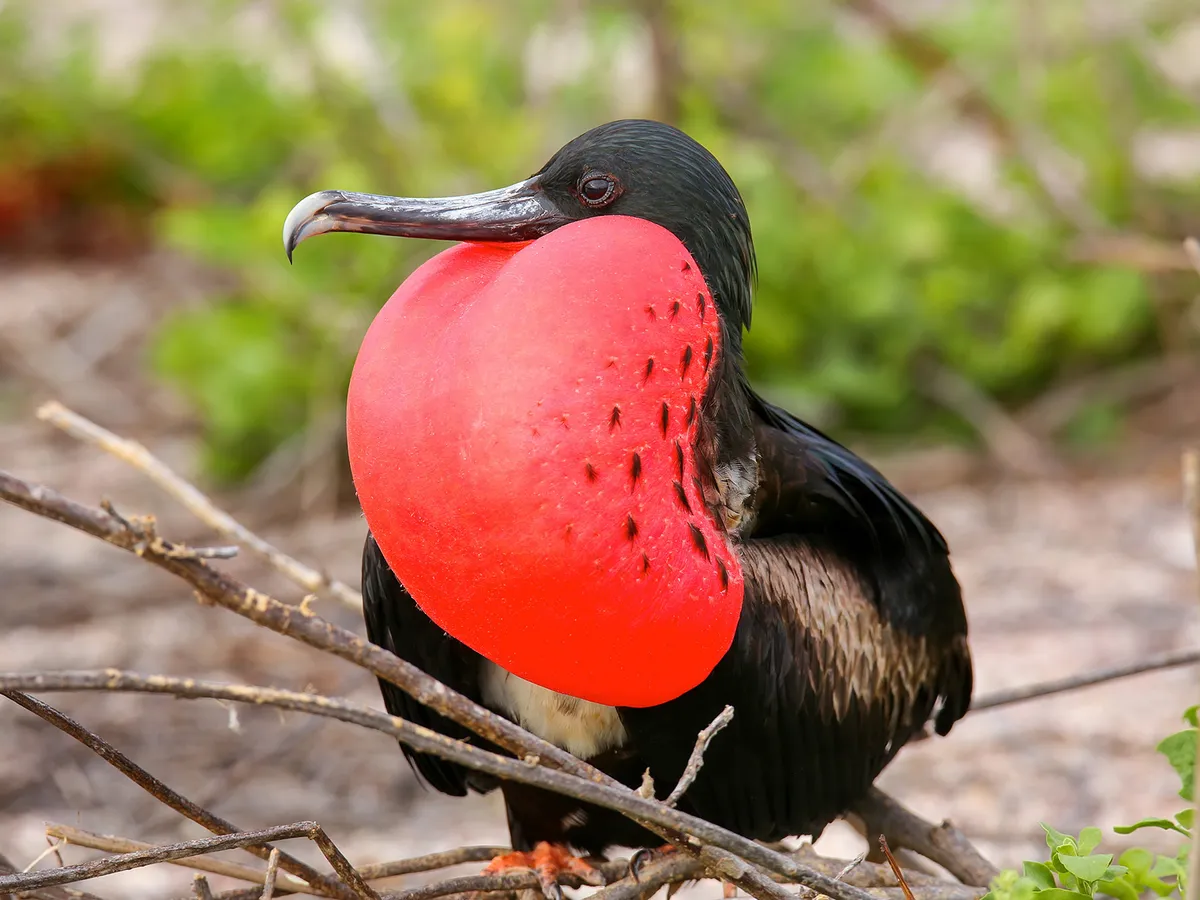 There are five species of frigatebirds, Magnificent, Great, Ascension, Christmas and Lesser. With their vast wingspan, they can spend weeks soaring above ocean waters, searching for food below.
There are five species of frigatebirds, Magnificent, Great, Ascension, Christmas and Lesser. With their vast wingspan, they can spend weeks soaring above ocean waters, searching for food below.
Two species live in the tropical regions of the Americas – Magnificent and Great – and if you’ve caught a glimpse of one overhead, you may be wondering “how big is a frigatebird?” If you’d like to find out then please read on.
Magnificent frigatebirds are the largest of the five frigatebird species, and have the largest wingspan to body size ratio of any bird. Their giant wings can measure up to nearly 2.4 m (7 ft 10 in) across and allow them to soar above ocean waters, hunting for food in the waters below.
Apart from the Lesser frigatebird, which is considerably smaller in size, the wingspan measurements of all frigatebird species can exceed 2 m (6 ft 7 in). This can be at least double the length of its body.
Their intimidating size allows them to successfully target other hunting birds in flight, and steal any fish or squid they have plucked from the marine waters for their own food, a practice known as kleptoparasitism. This gives rise to their nickname ‘pirate of the sea’ or ‘man o’ war bird’.
To learn more about how these soaring seabirds use their extreme wingspans to their advantage when it comes to searching for food and general survival, then please do keep reading.

Great Frigatebird in flight, with its colossal wingspan
Frigatebird wingspans
All five frigatebird species are noted for their vast wingspans, which gives them the ability to soar above marine waters for long periods. The Magnificent frigatebird holds the record for having the largest wingspan in proportion to its body size.
The range of wingspan measurement for each species is listed below:
- Magnificent frigatebird (Fregata magnificens): 217 to 244 cm (7 ft 1 in to 8 ft)
- Great frigatebird (Fregata minor): 205 to 230 cm (6 ft 9 in to 7 ft 7 in)
- Ascension frigatebird (Fregata aquila): 196 to 201 cm (6 ft 5 in to 6 ft 7 in)
- Christmas Island frigatebird (Fregata andrewsi): 205 to 230 cm (6 ft 9 in to 7 ft 7 in)
- Lesser frigatebird (Fregata ariel): 155 to 193 cm (5 ft 1 in to 6 ft 4 in)

Magnificent Frigatebird wingspans can reach up to 8ft!
Frigatebird weights
Female frigatebirds, across all five species, are larger and heavier than males, by up to 25 percent. Males are at the lower end of the range in each case, while the maximum recorded female weight represents the higher end of the range.

A male Christmas Island Frigatebird, a globally critically endangered species
Frigatebird body length
In comparison to their wingspans, the typical body length for each frigatebird species is considerably shorter. The range of body length for each species is listed here:
- Magnificent frigatebird: 89 to 144 cm (2 ft 11 in to 4 ft 9 in)
- Great frigatebird: 85 to 105 cm (2 ft 9 in to 3 ft 5 in)
- Ascension frigatebird: 89 to 96 cm (2 ft 11 in to 3 ft 2 in)
- Christmas Island frigatebird: 89 to 100cm (2 ft 9 in to 3 ft 3 in)
- Lesser frigatebird: 66 to 81 cm (2 ft 2 in to 2 ft 8 in)

Close up of a perched Ascension Frigatebird
How big are Frigatebirds compared to a human?
The maximum wingspan of each frigatebird species – even the smaller Lesser frigatebird – eclipses the height of the average human. Even humans that are considered exceptionally tall are generally far shorter than the outstretched wings of the largest Magnificent frigatebird, which measure up to 244 cm (8ft).
In terms of upright height or weight, a frigatebird is no match to a human, standing only a matter of inches off the ground and weighing less than 2 kg in the largest examples.
How big is the biggest Frigatebird?
The largest frigatebird species is the Magnificent frigatebird, which has a maximum recorded wingspan of 244 cm (8ft).

The Magnificent Frigatebird is the biggest species of Frigatebird
How big of an animal can a Frigatebird pick up?
Frigatebirds have webbed feet rather than sharp, gripping talons and are unable to pick up prey using their feet. They carry prey with their beaks, but usually, this is limited to large fish, squid and jellyfish, and young seabird chicks.
Frigatebirds are well known for their habit of kleptoparasitism, harᴀssing other birds mid-air so they drop any prey they have caught, while the opportunistic frigatebird then swoops down and steals it from the water’s surface.

Frigatebird catching a fish from the ocean
Why are Frigatebirds so big?
Frigatebirds are not anatomically built for hunting on land, as with their short legs, they are unable to walk well to find food. They take advantage of their colossal wing size to soar above marine waters, benefiting from thermal lift, and therefore covering large areas while they scan the ocean surface for fish.
They are nonswimmers, and will simply swoop into the water and pluck out any suitable prey with their razor-sharp beaks, particularly squid, fish, crustaceans, and jellyfish.
Being such an intimidating presence in the sky also works in their favor, as they frequently gain food by hᴀssling smaller birds to drop any prey they have caught, and then plunging down to claim it for themselves.

Close up of a male Magnificent frigatebird in flight with red pouch
Frigatebirds compared to other bird species
While frigatebirds hold the status of having the largest wingspan compared to body size, they are by no means the seabird with the largest wings. The Dalmatian pelican’s wingspan is an enviable 2.70 to 3.20 m (8.9 to 10.5 ft), while the wandering albatross has the largest wingspan of all living birds, ranging from 2.51 to 3.5 m (8 ft 3 in to 11 ft 6 in).
While many birds of prey, including the golden eagle, bald eagle, cinereous vulture and California condor have a greater maximum wingspan than the largest frigatebirds, some prolific hunters, including the eagle owl, osprey and harpy eagle, do have wingtip-to-wingtip measurements that are eclipsed by those of frigatebirds. The maximum wingspan of a Magnificent frigatebird is double the length of that of a peregrine falcon.





